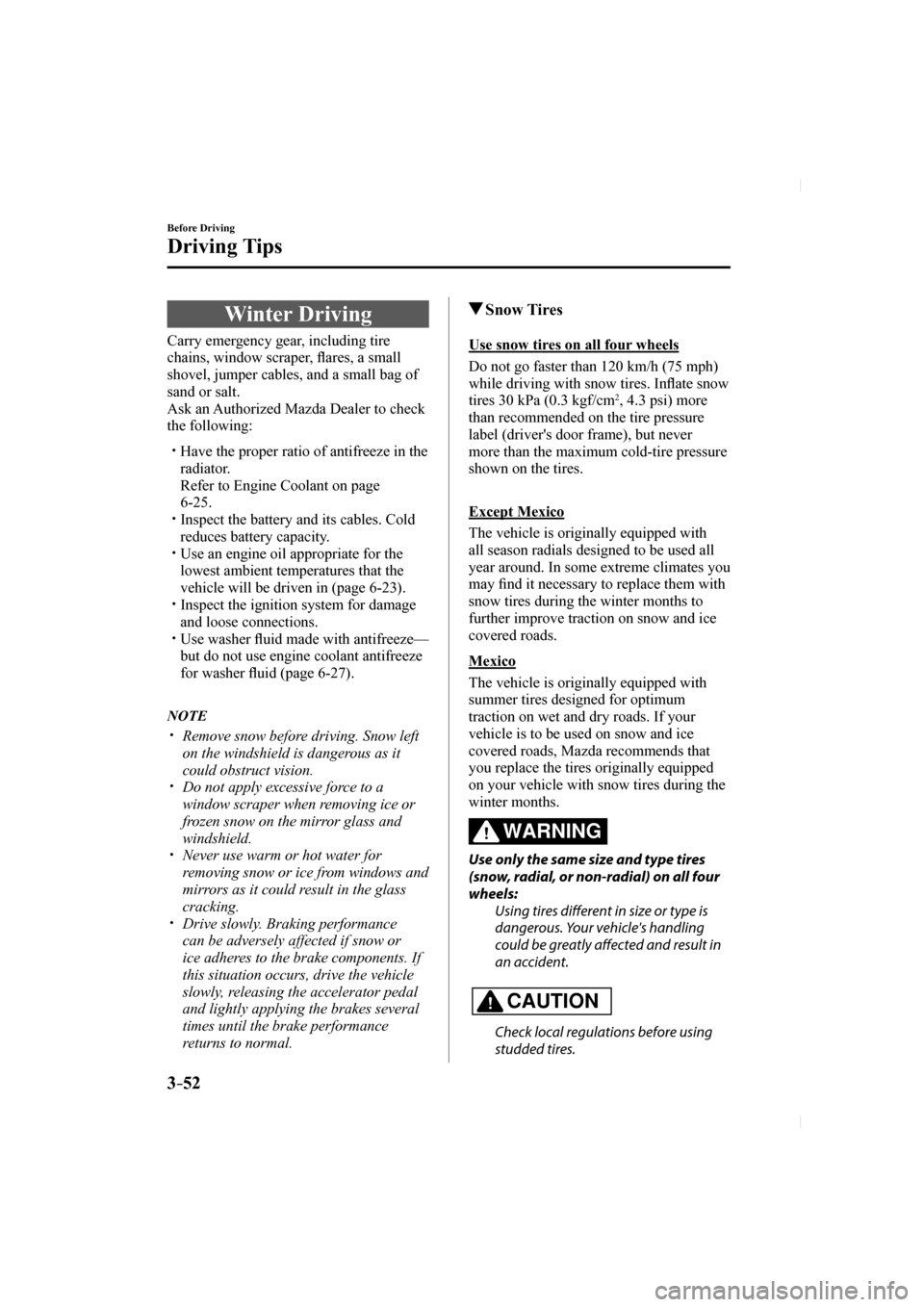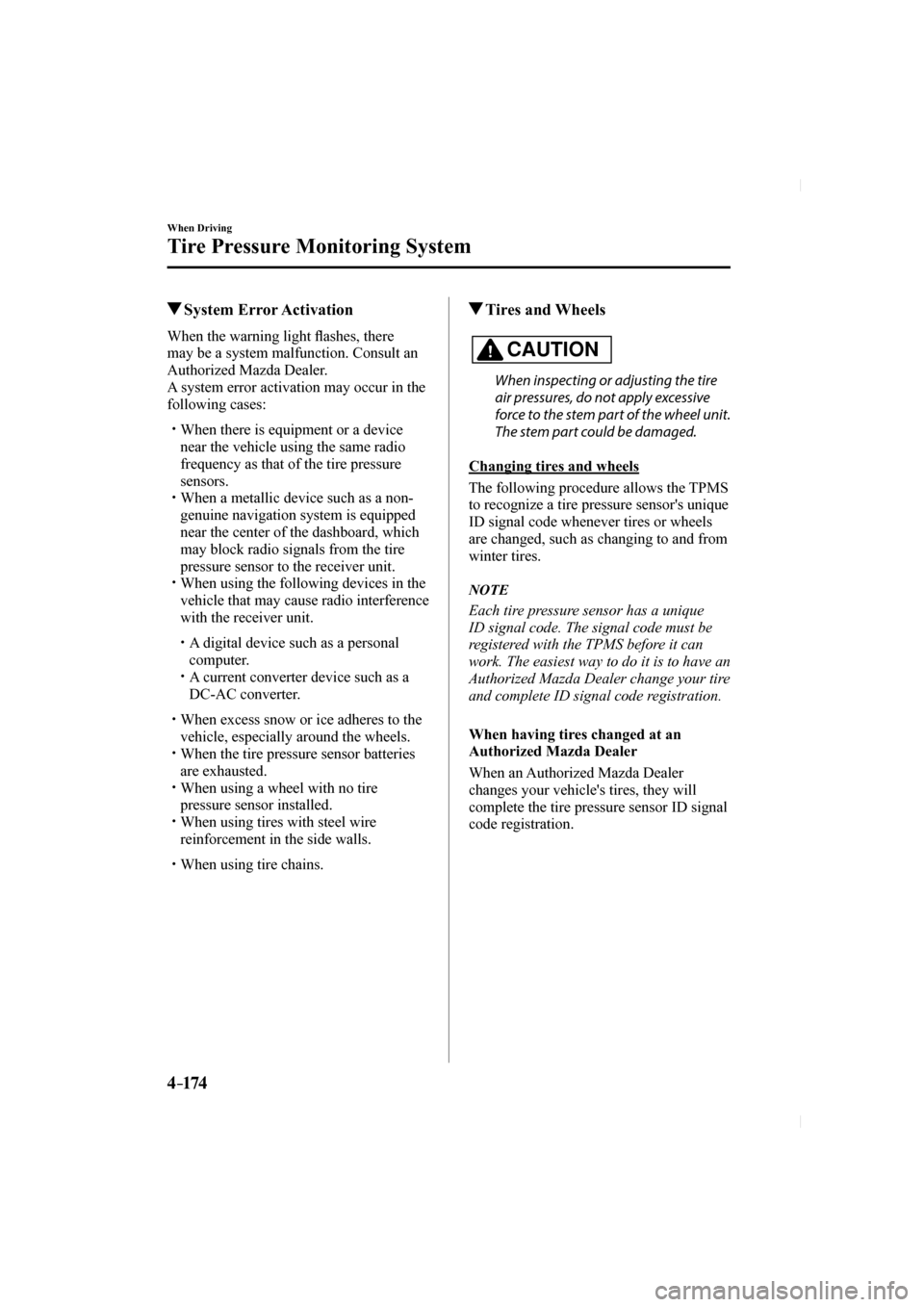winter tires MAZDA MODEL CX-5 2017 Owners Manual (in English)
[x] Cancel search | Manufacturer: MAZDA, Model Year: 2017, Model line: MODEL CX-5, Model: MAZDA MODEL CX-5 2017Pages: 664, PDF Size: 11.73 MB
Page 132 of 664

3–52
Before Driving
Driving Tips
Winter Driving
Carry emergency gear, including tire
chains, window scraper, fl ares, a small
shovel, jumper cables, and a small bag of
sand or salt.
Ask an Authorized Mazda Dealer to check
the following:
Have the proper ratio of antifreeze in the
radiator.
Refer to Engine Coolant on page 6-25 .
Inspect the battery and its cables. Cold
reduces battery capacity.
Use an engine oil appropriate for the
lowest ambient temperatures that the
vehicle will be driven in (page 6-23 ).
Inspect the ignition system for damage
and loose connections.
Use washer fl uid made with antifreeze—
but do not use engine coolant antifreeze
for washer fl uid (page 6-27 ).
NOTE
Remove snow before driving. Snow left
on the windshield is dangerous as it
could obstruct vision.
Do not apply excessive force to a
window scraper when removing ice or
frozen snow on the mirror glass and
windshield.
Never use warm or hot water for
removing snow or ice from windows and
mirrors as it could result in the glass
cracking.
Drive slowly. Braking performance
can be adversely affected if snow or
ice adheres to the brake components. If
this situation occurs, drive the vehicle
slowly, releasing the accelerator pedal
and lightly applying the brakes several
times until the brake performance
returns to normal.
Snow Tires
Use snow tires on all four wheels
Do not go faster than 120 km/h (75 mph)
while driving with snow tires. In fl ate snow
tires 30 kPa (0.3 kgf/cm
2 , 4.3 psi) more
than recommended on the tire pressure
label (driver's door frame), but never
more than the maximum cold-tire pressure
shown on the tires.
Except Mexico
The vehicle is originally equipped with
all season radials designed to be used all
year around. In some extreme climates you
may fi nd it necessary to replace them with
snow tires during the winter months to
further improve traction on snow and ice
covered roads.
Mexico
The vehicle is originally equipped with
summer tires designed for optimum
traction on wet and dry roads. If your
vehicle is to be used on snow and ice
covered roads, Mazda recommends that
you replace the tires originally equipped
on your vehicle with snow tires during the
winter months.
WARNING
Use only the same size and type tires
(snow, radial, or non-radial) on all four
wheels: Using tires diff erent in size or type is
dangerous. Your vehicle's handling
could be greatly aff ected and result in
an accident.
CAUTION
Check local regulations before using
studded tires.
CX-5_8FN1-EA-16L_Edition1.indb 522016/12/12 10:05:38
Page 234 of 664

4–90
When Driving
i-ACTIV AWD
Tires and Tire Chains
The condition of the tires plays a large
role in the performance of the vehicle.
Moreover, to prevent adverse effects to the
drive assembly, please note the following:
Tires
When replacing tires, always replace all
front and rear tires at the same time.
All tires must be of the same size,
manufacture, brand and tread pattern.
Pay particular attention when equipping
snow or other types of winter tires.
Do not mix tread-worn tires with normal
tires.
Inspect tire in fl ation pressures at the
specifi ed periods adjust to the speci fi ed
pressures.
NOTE
Check the tire in fl ation pressure label
attached to driver's door frame for the
correct tire in fl ation pressure.
Make sure to equip the vehicle with
genuine wheels of the speci fi ed size, on
all wheels. With AWD, the system is
calibrated for all four wheels being of
the same dimensions.
Tire chains
Install tire chains to the front tires. Do not use tire chains on the rear
wheels.
Do not drive the vehicle faster than
30 km/h (19 mph) with the tire chains
installed.
Do not drive the vehicle with tire chains
on road conditions other than snow or
ice.
Towing
If the vehicle requires towing, have it
towed with all four wheels completely off
the ground.
Refer to Towing Description on page
7-20 .
CX-5_8FN1-EA-16L_Edition1.indb 902016/12/12 10:06:04
Page 318 of 664

4–174
When Driving
Tire Pressure Monitoring System
System Error Activation
When the warning light fl ashes, there
may be a system malfunction. Consult an
Authorized Mazda Dealer.
A system error activation may occur in the
following cases:
When there is equipment or a device
near the vehicle using the same radio
frequency as that of the tire pressure
sensors.
When a metallic device such as a non-
genuine navigation system is equipped
near the center of the dashboard, which
may block radio signals from the tire
pressure sensor to the receiver unit.
When using the following devices in the
vehicle that may cause radio interference
with the receiver unit.
A digital device such as a personal computer.
A current converter device such as a DC-AC converter.
When excess snow or ice adheres to the
vehicle, especially around the wheels.
When the tire pressure sensor batteries
are exhausted.
When using a wheel with no tire
pressure sensor installed.
When using tires with steel wire
reinforcement in the side walls.
When using tire chains.
Tires and Wheels
CAUTION
When inspecting or adjusting the tire
air pressures, do not apply excessive
force to the stem part of the wheel unit.
The stem part could be damaged.
Changing tires and wheels
The following procedure allows the TPMS
to recognize a tire pressure sensor's unique
ID signal code whenever tires or wheels
are changed, such as changing to and from
winter tires.
NOTE
Each tire pressure sensor has a unique
ID signal code. The signal code must be
registered with the TPMS before it can
work. The easiest way to do it is to have an
Authorized Mazda Dealer change your tire
and complete ID signal code registration.
When having tires changed at an
Authorized Mazda Dealer
When an Authorized Mazda Dealer
changes your vehicle's tires, they will
complete the tire pressure sensor ID signal
code registration.
CX-5_8FN1-EA-16L_Edition1.indb 1742016/12/12 10:06:20